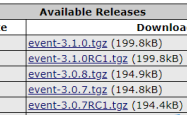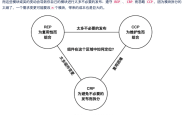详解PHP的7个预定义接口
目录
- 1. Traversable(遍历)接口
- 2. Iterator(迭代器)接口
- 3. IteratorAggregate(聚合迭代器) 接口
- 4.ArrayAccess(数组式访问)接口
- 5. Serializable (序列化)接口
- 6. Closure 类
- 7. Generator (生成器)
1. Traversable(遍历)接口
该接口不能被类直接实现,如果直接写了一个普通类实现了该遍历接口,是会直接报致命的错误,提示使用 Iterator(迭代器接口)或者 IteratorAggregate(聚合迭代器接口)来实现,这两个接口后面会介绍;所有通常情况下,我们只是会用来判断该类是否可以使用 foreach 来进行遍历;
?| 1 2 3 4 5 6 | class Test implements Traversable { } 上面这个是错误示范,该代码会提示这样的错误: Fatal error: Class Test must implement interface Traversable as part of either Iterator or IteratorAggregate in Unknown on line 0 |
上面的大致意思是说如要实现这个接口,必须同Iterator或者IteratorAggregate来实现 正确的做法: 当我们要判断一个类是否可以使用foreach来进行遍历,只需要判断是否是traversable的实例
?| 1 2 3 4 5 | class Test { } $test = new Test; var_dump( $test instanceOf Traversable); |
2. Iterator(迭代器)接口
迭代器接口其实实现的原理就是类似指针的移动,当我们写一个类的时候,通过实现对应的 5 个方法:key(),current(),next(),rewind(),valid(),就可以实现数据的迭代移动,具体看以下代码
?| 1 2 3 4 5 6 7 8 9 10 11 12 13 14 15 16 17 18 19 20 21 22 23 24 25 26 27 28 29 30 31 32 33 34 35 36 37 38 39 40 41 42 43 44 | <?php class Test implements Iterator { private $key ; private $val = [ 'one' , 'two' , 'three' , ]; public function key() { return $this ->key; } public function current() { return $this ->val[ $this ->key]; } public function next() { ++ $this ->key; } public function rewind () { $this ->key = 0; } public function valid() { return isset( $this ->val[ $this ->key]); } } $test = new Test; $test -> rewind (); while ( $test ->valid()) { echo $test ->key . ':' . $test ->current() . PHP_EOL; $test ->next(); } |
## 该输出结果 :
0: one
1: two
2: three
看了这个原理我们就知道,其实迭代的移动方式:rewind()-> valid()->key() -> current() -> next() -> valid()-> key() ....-> valid();
好的,理解了上面,我们打开Iterator的接口,发现它是实现了Traversable(遍历)接口的,接下来我们来证明下:
var_dump($test instanceOf Traversable);
结果返回的是true,证明这个类的对象是可以进行遍历的。
?| 1 2 3 | foreach ( $test as $key => $value ){ echo $test ->key . ':' . $test ->current() . PHP_EOL; } |
这个的结果跟while循环实现的模式是一样的。
3. IteratorAggregate(聚合迭代器) 接口
聚合迭代器和迭代器的原理是一样的,只不过聚合迭代器已经实现了迭代器原理,你只需要实现一个 getIterator()方法来实现迭代,具体看以下代码
?| 1 2 3 4 5 6 7 8 9 10 11 12 13 14 15 16 17 18 19 20 21 22 23 24 25 26 27 28 29 30 31 32 33 34 35 36 37 38 39 40 41 42 43 44 45 46 47 48 49 50 51 52 53 54 55 56 | <?php class Test implements IteratorAggregate { public $one = 1; public $two = 2; public $three = 3; public function __construct() { $this ->four = 4; } public function getIterator() { return new AraayIterator( $this ); } } $test = ( new Test())->getIterator(); $test -> rewind (); while ( $test ->valid()) { echo $test ->key() . ' : ' . $test ->current() . PHP_EOL; $test ->next(); } //从上面的代码,我们可以看到我们将Test类的对象传进去当做迭代器,通过while循环的话,我们必须通过调用getIterator()方法获取到迭代器对象,然后直接进行迭代输出,而不需要去实现相关的key()等方法。 //当然这个时候,我们肯定想知道是否可以直接从foreach进行迭代循环出去呢?那么我们来打印一下结果 $test = new Test; var_dump( $test instanceOf Traversable); //结果是输出bool true,所以我们接下来是直接用foreach来实现一下。 $test = new Test; foreach ( $test as $key => $value ) { echo $key . ' : ' . $value . PHP_EOL; } //接下来,我们看到是对对象进行迭代,这个时候我们是否可以数组进行迭代呢? class Test implements IteratorAggregate { public $data ; public function __construct() { $this ->data = [ '' one ' => 1 , ' two' => 2]; } public function getIterator() { return new AraayIterator( $this ->data); } } //同理实现的方式跟对对象进行迭代是一样的。 |
4.ArrayAccess(数组式访问)接口
通常情况下,我们会看到 this ['name'] 这样的用法,但是我们知道,$this 是一个对象,是如何使用数组方式访问的?答案就是实现了数据组访问接口 ArrayAccess,具体代码如下
?| 1 2 3 4 5 6 7 8 9 10 11 12 13 14 15 16 17 18 19 20 21 22 23 24 25 26 27 28 29 30 31 32 33 34 35 36 37 38 39 40 41 42 43 44 45 46 47 48 49 50 51 52 53 54 55 56 57 58 59 60 61 62 63 64 65 66 67 68 69 70 71 72 73 74 75 76 77 78 79 80 81 82 83 84 85 86 87 88 89 90 91 92 | <?php class Test implements ArrayAccess { public $container ; public function __construct() { $this ->container = [ 'one' => 1, 'two' => 2, 'three' => 3, ]; } public function offsetExists( $offset ) { return isset( $this ->container[ $offset ]); } public function offsetGet( $offset ) { return isset( $this ->container[ $offset ]) ? $this ->container[ $offset ] : null; } public function offsetSet( $offset , $value ) { if ( is_null ( $offset )) { $this ->container[] = $value ; } else { $this ->container[ $offset ] = $value ; } } public function offsetUnset( $offset ) { unset( $this ->container[ $offset ]); } } $test = new Test; var_dump(isset( $test [ 'one' ])); var_dump( $test [ 'two' ]); unset( $test [ 'two' ]); var_dump(isset( $test [ 'two' ])); $test [ 'two' ] = 22; var_dump( $test [ 'two' ]); $test [] = 4; var_dump( $test ); var_dump( $test [0]); //当然我们也有经典的一个做法就是把对象的属性当做数组来访问 class Test implements ArrayAccess { public $name ; public function __construct() { $this ->name = 'gabe' ; } public function offsetExists( $offset ) { return isset( $this -> $offset ); } public function offsetGet( $offset ) { return isset( $this -> $offset ) ? $this -> $offset : null; } public function offsetSet( $offset , $value ) { $this -> $offset = $value ; } public function offsetUnset( $offset ) { unset( $this -> $offset ); } } $test = new Test; var_dump(isset( $test [ 'name' ])); var_dump( $test [ 'name' ]); var_dump( $test [ 'age' ]); $test [1] = '22' ; var_dump( $test ); unset( $test [ 'name' ]); var_dump(isset( $test [ 'name' ])); var_dump( $test ); $test [] = 'hello world' ; var_dump( $test ); |
5. Serializable (序列化)接口
通常情况下,如果我们的类中定义了魔术方法,sleep(),wakeup () 的话,我们在进行 serialize () 的时候,会先调用sleep () 的魔术方法,我们通过返回一个数组,来定义对对象的哪些属性进行序列化,同理,我们在调用反序列化 unserialize () 方法的时候,也会先调用的wakeup()魔术方法,我们可以进行初始化,如对一个对象的属性进行赋值等操作;但是如果该类实现了序列化接口,我们就必须实现 serialize()方法和 unserialize () 方法,同时sleep()和wakeup () 两个魔术方法都会同时不再支持,具体代码看如下;
?| 1 2 3 4 5 6 7 8 9 10 11 12 13 14 15 16 17 18 19 20 21 22 23 24 25 26 27 28 29 30 31 32 33 34 35 36 37 38 39 40 41 42 43 44 45 46 47 48 49 50 51 52 53 54 55 56 57 58 59 60 61 62 63 64 65 66 67 68 69 70 | <?php class Test { public $name ; public $age ; public function __construct() { $this ->name = 'gabe' ; $this ->age = 25; } public function __wakeup() { var_dump( __METHOD__ ); $this ->age++; } public function __sleep() { var_dump( __METHOD__ ); return [ 'name' ]; } } $test = new Test; $a = serialize( $test ); var_dump( $a ); var_dump(unserialize( $a )); //实现序列化接口,发现魔术方法失效了 class Test implements Serializable { public $name ; public $age ; public function __construct() { $this ->name = 'gabe' ; $this ->age = 25; } public function __wakeup() { var_dump( __METHOD__ ); $this ->age++; } public function __sleep() { var_dump( __METHOD__ ); return [ 'name' ]; } public function serialize() { return serialize( $this ->name); } public function unserialize( $serialized ) { $this ->name = unserialize( $serialized ); $this ->age = 1; } } $test = new Test; $a = serialize( $test ); var_dump( $a ); var_dump(unserialize( $a )); |
6. Closure 类
用于代表匿名函数的类,凡是匿名函数其实返回的都是 Closure 闭包类的一个实例,该类中主要有两个方法,bindTo()和 bind(),通过查看源码,可以发现两个方法是殊途同归,只不过是 bind () 是个静态方法,具体用法看如下;
?| 1 2 3 4 5 6 7 | <?php $closure = function () { return 'hello world' ; } var_dump( $closure ); var_dump( $closure ()); |
通过上面的例子,可以看出第一个打印出来的是 Closure 的一个实例,而第二个就是打印出匿名函数返回的 hello world 字符串;接下来是使用这个匿名类的方法,这两个方法的目的都是把匿名函数绑定一个类上使用;
bindTo()
?| 1 2 3 4 5 6 7 8 9 10 11 12 13 14 15 16 17 18 19 20 21 22 23 24 25 26 27 28 | <?php namespace demo1; class Test { private $name = 'hello woeld' ; } $closure = function () { return $this ->name; } $func = $closure ->bindTo( new Test); $func (); // 这个是可以访问不到私有属性的,会报出无法访问私有属性 // 下面这个是正确的做法 $func = $closure ->bindTo( new Test, Test:: class ); $func (); namespace demo2; class Test { private statis $name = 'hello world' ; } $closure = function () { return self:: $name ; } $func = $closure ->bindTo(null, Test:: class ); $func (); |
bind()
?| 1 2 3 4 5 6 7 8 9 10 11 12 13 14 15 16 17 18 19 20 21 22 23 24 | <?php namespace demo1; class Test { private $name = 'hello world' ; } $func = \Closure::bind( function () { return $this ->name; }, new Test, Test:: class ); $func (); namespace demo2; class Test { private static $name = 'hello world' ; } $func = \Closure::bind( function () { return self:: $name ; }, null, Test:: class ); $func () |
7. Generator (生成器)
Generator 实现了 Iterator,但是他无法被继承,同时也生成实例。既然实现了 Iterator,所以正如上文所介绍,他也就有了和 Iterator 相同的功能:rewind->valid->current->key->next...,Generator 的语法主要来自于关键字 yield。yield 就好比一次循环的中转站,记录本次的活动轨迹,返回一个 Generator 的实例。Generator 的优点在于,当我们要使用到大数据的遍历,或者说大文件的读写,而我们的内存不够的情况下,能够极大的减少我们对于内存的消耗,因为传统的遍历会返回所有的数据,这个数据存在内存上,而 yield 只会返回当前的值,不过当我们在使用 yield 时,其实其中会有一个处理记忆体的过程,所以实际上这是一个用时间换空间的办法。
?| 1 2 3 4 5 6 7 8 9 10 11 12 | <?php $start_time = microtime(true); function xrange(int $num ){ for ( $i = 0; $i < $num ; $i ++) { yield $i ; } } $generator = xrange(100000); foreach ( $generator as $key => $value ) { echo $key . ': ' . $value . PHP_EOL; } echo 'memory: ' . memory_get_usage() . ' time: ' . (microtime(true) - $start_time ); |
输出:
?memory: 388904 time: 0.12135100364685
| 1 2 3 4 5 6 7 8 9 10 11 12 13 14 | <?php $start_time = microtime(true); function xrange(int $num ){ $arr = []; for ( $i = 0; $i < $num ; $i ++) { array_push ( $arr , $i ); } return $arr ; } $arr = xrange(100000); foreach ( $arr as $key => $value ) { echo $key . ': ' . $value . PHP_EOL; } echo 'memory: ' . memory_get_usage() . ' time: ' . (microtime(true) - $start_time ); |
输出:
memory: 6680312 time: 0.10804104804993
以上就是详解PHP的7个预定义接口的详细内容,更多关于PHP的7个预定义接口的资料请关注服务器之家其它相关文章!
原文链接:https://www.cnblogs.com/a609251438/p/11867558.html
1.本站遵循行业规范,任何转载的稿件都会明确标注作者和来源;2.本站的原创文章,请转载时务必注明文章作者和来源,不尊重原创的行为我们将追究责任;3.作者投稿可能会经我们编辑修改或补充。











